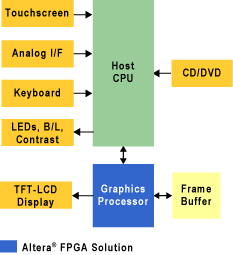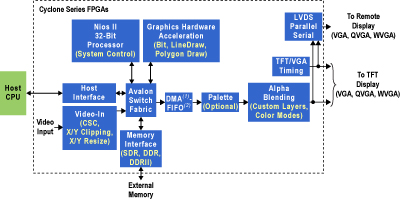The automoTIve industry is taking a close look at programmable logic devices (PLDs) and how they can contribute to the success of both system suppliers and automakers (original equipment manufacturers). With a lowering cost structure and increasing system performance, PLDs are entering the mainstream automotive market. Unlike ASSP solutions, PLDs provide flexibility that is an ever increasing requirement in the automotive industry.
PLDs, which have already found a home in the infotainment and communications markets, are included in designs for the emerging driver assistance automotive segment. This segment consists of some of the fastest growing applications, including lane departure warning, night vision, and tire pressure monitoring. With a low silicon cost structure, abundance of intellectual property (IP) cores, reference designs, and a long product shelf life, PLDs are an ideal choice for the growing automotive electronics market.
Automotive electronics such as navigation systems, rear seat entertainment systems, and game consoles are increasingly integrated in new cars, but these consumer applications require a significant amount of graphics processing. Additionally, lane departure warning systems and night vision systems also involve a large amount of graphics processing. New technology is making it possible to have the same high-level graphic quality in your car as you do in your home theater.
FPGAs are redefining this new technology and making it feasible to implement electronic systems that can provide the highest graphics processing capabilities. The advantage of Altera® FPGAs is that they can provide a far more flexible solution than simple interfacing between the microprocessor and the multiple consumer interface standards. The FPGA architecture allows for extremely efficient high-speed data routing. Processing of this data can occur in parallel within the digital domain in the FPGA rather than moving it to an external microprocessor for serial operation.
Navigation Systems
A navigation system is one of the key applications within the automotive space that utilizes a fair amount of graphics processing. The graphics processing complexity varies from a simple turn-by-turn (TBT) navigation to a more sophisticated 3D navigation system. Figure 1 shows a typical block diagram of a navigation system. The architecture consists of a host CPU (which is generally a Hitachi SH4, Motorola Power PC, or a TI OMAP processor) with a graphics processor. Various peripherals talk to these processors, including keyboards and thin-film transistor (TFT) displays.
Figure 1. Typical Navigation System

Graphics processing requires the computation of numerous algorithms such as scaling, filtering, and alpha blending. Unlike digital signal processors or ASSPs, FPGAs are better suited to perform these computationally-intensive algorithms because they can handle multiple instructions in a single clock cycle.
Figure 2 shows a low-cost graphics implementation. The video-in can be a BT.656 input (YUV 4:2:2), with color space converter (CSC) to output RGB. The memory interface to the Avalon® switch fabric allows high graphic computations to be accommodated. Memory types that are supported include: single data rate (SDR), double data rate (DDR), and DDRII. The Altera Nios® II 32-bit embedded processor is primarily used for graphics processing (line draw, frame creation) and provides additional control functions. Graphics hardware acceleration can include functions such as BitBlt (copy object into frame buffer, 2D-DMA transfer, possibly with blending). Alpha blending can have multiple channels. The Cyclone® FPGA series is capable of supporting LVDS graphics output for remote display applications.
Figure 2. Low-Cost Graphics Implementation


